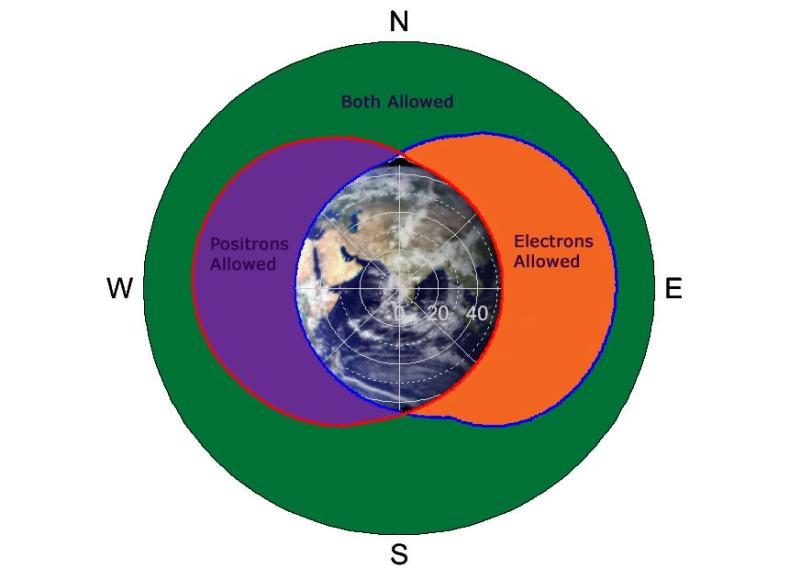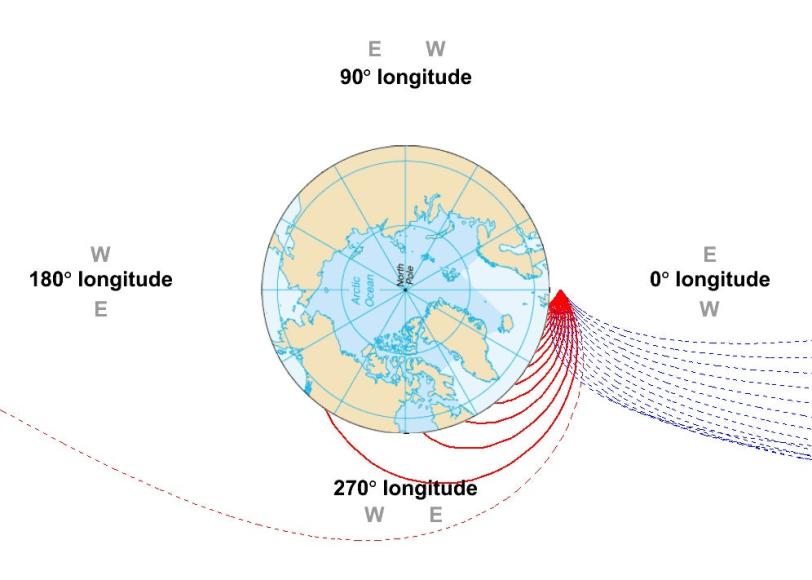Fermi Gamma-ray Space Telescope Confirms Puzzling Preponderance of Positrons
By finding a clever way to use the Earth itself as a scientific instrument, members of a SLAC-led research team turned the Fermi Gamma-ray Space Telescope into a positron detector – and confirmed a startling discovery from 2009 that found an excess of these antimatter particles in cosmic rays, a possible sign of dark matter.
By Lori Ann White
By finding a clever way to use the Earth itself as a scientific instrument, members of a SLAC-led research team turned the Fermi Gamma-ray Space Telescope into a positron detector – and confirmed a startling discovery from 2009 that found an excess of these antimatter particles in cosmic rays, a possible sign of dark matter.
That earlier discovery by an instrument called PAMELA had set off a burst of speculation: Did the extra positrons – the antimatter mates of electrons – come from an astrophysical source, such as pulsars, or from a more exotic origin – the annihilation of dark matter particles? Both sources have their proponents. Pulsars are maelstroms of magnetic forces that are still not easily understood, and while dark matter particles are slippery customers, through gravity dark matter has had a big effect, shaping galaxies and influencing the structure of the universe.
The Fermi results, reported in a paper posted on a physics website and submitted to the journal Physical Review Letters, doesn’t settle the question of where the extra positrons came from. But they represent an important confirmation of the earlier results, and extend the observation to more energetic positrons than before.
This confirmation of the PAMELA results "is extremely important whether it's dark matter or not," said Michael Peskin, a theoretical physicist at SLAC and a dark matter expert. Not everyone accepted the PAMELA results, according to Peskin: "There was some doubt the effect was real."
While the positron debate percolated, the team working with Fermi’s main instrument, the Large Area Telescope, quietly started making it jump through hoops.
Since the LAT was designed to detect neutral photons – gamma rays, the highest-energy photons known in the universe – it doesn’t carry the magnet needed to separate negatively-charged electrons from positively-charged positrons, so the LAT team could count them.
“The Fermi satellite is not a perfect instrument to look for electrons and positrons,” said Stefan Funk of the joint SLAC/Stanford Kavli Institute for Particle Astrophysics and Cosmology, who led the team that analyzed the current results. The LAT was not designed to distinguish electrons and positrons, and this is hard to change, since the satellite is now in orbit 340 miles above the Earth.
Then another KIPAC professor named Roger Romani pointed out that the LAT actually did have access to a magnet – the Earth. The Earth's magnetic field naturally bends the paths of charged particles approaching from space and the Earth's bulk blocks the paths of positrons coming in from some directions, and electrons coming in from other directions. Combined, these two effects can be used to tell the LAT what regions of the sky to look in order to see only positrons or only electrons. “It’s essentially using the Earth’s magnetic field as a particle selector,” Funk said, “and the Earth itself as a shutter – ” a simple concept, but, added Funk, not simple in execution. He especially commended graduate student Warit Mitthumsiri and KIPAC post-doctoral researcher Justin Vandenbroucke as deserving of kudos for their efforts.
According to Vandenbroucke, the analysis team had as much chance to stretch their abilities as the LAT did. "The most fun part of the analysis was learning about the Earth's magnetic field and using a detailed map of it that had been produced by an international team of geophysicists," he said.
The technique had been used before in balloon-based experiments, Funk explained, but low-flying balloons don’t have the panoramic view that the LAT does, and did not produce very robust results. "We’re far away so we can essentially see the whole Earth, and this is why we can use this technique over a large energy range,” he said.
Mitthumsiri said he hopes the LAT results have put the doubts to rest. "Some people have argued that the positron excess we and PAMELA see may be the residuals of much more abundant cosmic-ray background particles which neither we nor PAMELA subtracted out correctly. So we used two independent techniques to subtract out the background – one based on particle simulation and the other using flight data fitting. They gave consistent results with each other. This is a strong check of our analysis."
The results have turned up the heat on the simmering debate over the source of the extra positrons.
If dark matter is involved, the positrons discovered by PAMELA and Fermi team would signify a type of dark matter called Weakly Interacting Massive Particles (WIMPs). Several experiments – HEAT, CAPRICE, and AMS-01 – had found excess positrons among particles with energies over about 7 GeV, or billion electron volts. PAMELA extended those measurements to about 100 GeV. Now the LAT has found excess positrons at up to 200 GeV, the highest energy it can measure.
Since theory predicts that the energy of the excess positrons would be directly tied to the mass of the WIMPs that spit them out, this would indicate that dark matter particles are truly massive – more massive than some scientists are comfortable with.
For example, a recent article in New Scientist quoted Pasquale Serpico, of the Annecy-Le-Vieux Theoretical Physics Laboratory, as saying, "The FERMI result all but rules out a dark-matter interpretation for [the PAMELA] signal."
Dan Hooper, a theoretical physicist at the Fermi National Accelerator Laboratory, said he would not word his conclusions so strongly, but added that he tends to agree that dark matter is not the source of the positrons. "The whole dark matter interpretation of this has become rather strained," he said. He favors pulsars instead.
Meanwhile, Neal Weiner of New York University and his colleague Douglas Finkbeiner of Harvard have explored models of dark matter massive enough to make positrons at 200 GeV and above. "These models allow the positron fraction to increase with energy, all the way up to several hundred GeV," Finkbeiner said, adding "Even if dark matter is probably not the source, we have to consider the possibility."
But the problem goes deeper than pulsar versus dark matter particle. As Finkbeiner explained, there's no way to distinguish between the sources at this point, and if positrons of even higher energies continue to pop up, as he thinks will happen, the pulsar explanation will become strained as well. "I think it's clear there's something interesting going on,” he said, “but what it is....”
While theorists wrestle with the whys and wherefores as they await more data, they can agree on one thing: The LAT results are an experimental tour-de-force. "I think it's a phenomenal accomplishment," said Hooper. Peskin termed the results "beautiful."
Funk takes a more modest view. "We tried our best to get everything out of the instrument," he said.

(Image courtesy Justin Vandenbroucke, Fermi-LAT collaboration)

(Image courtesy Justin Vandenbroucke, Fermi-LAT collaboration)